
Sam Hallas' Website
The BT Museum Memorial Pages - Telephony Items - 1
Bell Receiver
 One of Bell's early receiver designs made in wood. The magnet occupied
the length of the handle and the diaphragm was housed in the larger diameter
section at the bottom of the picture. This design is often called the
"butterstamp" after its resemblance to the device used for pressing
pats of butter.
One of Bell's early receiver designs made in wood. The magnet occupied
the length of the handle and the diaphragm was housed in the larger diameter
section at the bottom of the picture. This design is often called the
"butterstamp" after its resemblance to the device used for pressing
pats of butter.
Bell Transmitter
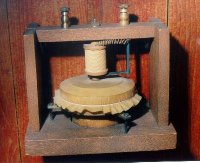 A reconstruction of one of Bell's prototype microphones. The metal diaphragm is
mounted on a skin stretched over the pudding-basin-like structure at the bottom.
The coil in which the electrical signals are induced is suspended above. Evidence later
emerged that Bell's original experiments with Watson used a microphone consisting of
a wire dipped in liquid similar to that invented by Elisha Gray. This "gallows
frame" microphone could transmit sounds but not clear speech.
A reconstruction of one of Bell's prototype microphones. The metal diaphragm is
mounted on a skin stretched over the pudding-basin-like structure at the bottom.
The coil in which the electrical signals are induced is suspended above. Evidence later
emerged that Bell's original experiments with Watson used a microphone consisting of
a wire dipped in liquid similar to that invented by Elisha Gray. This "gallows
frame" microphone could transmit sounds but not clear speech.
Carbon Button Transmitter
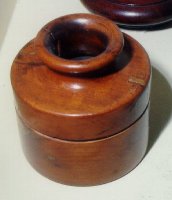 Bell's transmitter had limited output and consequently the range of communication was
limited. The invention of the carbon microphone by T. Edison, based on the work of
Blake and Berliner, considerably improved the range of
the telephone at the expense of requiring power in the form of a local battery. Two
carbon buttons were placed in contact. One was fixed and the other attached to a
diaphragm. Speech caused the buttons to be pressed closer together, reducing the
electrical resistance and allowing more current to flow.
Bell's transmitter had limited output and consequently the range of communication was
limited. The invention of the carbon microphone by T. Edison, based on the work of
Blake and Berliner, considerably improved the range of
the telephone at the expense of requiring power in the form of a local battery. Two
carbon buttons were placed in contact. One was fixed and the other attached to a
diaphragm. Speech caused the buttons to be pressed closer together, reducing the
electrical resistance and allowing more current to flow.
Crossley Magneto Telephone
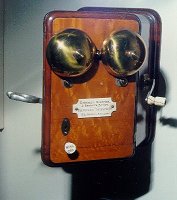 The legend reads "Crossley, Harrison & Emmott's Patent, The Crossley Telephone
Company, Bradford, England."
The legend reads "Crossley, Harrison & Emmott's Patent, The Crossley Telephone
Company, Bradford, England."
Crossley Wall Telephone
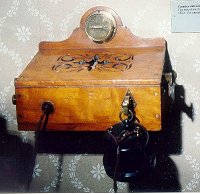 This was one of the first types of telephone to be used by the Post Office from about
1878 onwards. The microphone was concealed behind the fancy carving on the lid. Other
illustrations of this model show the traditional butterstamp design of receiver.
This was one of the first types of telephone to be used by the Post Office from about
1878 onwards. The microphone was concealed behind the fancy carving on the lid. Other
illustrations of this model show the traditional butterstamp design of receiver.
Gower-Bell Telephone
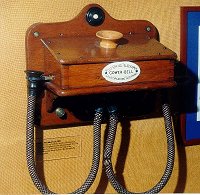 The Post Office converted many of its small public telegraph offices to
public telephones using this design of instrument, circa 1881.
The receiver was contained inside the case, connected to the two tubes which were
held against the ears. The microphone was behind the small funnel in the top.
The Post Office converted many of its small public telegraph offices to
public telephones using this design of instrument, circa 1881.
The receiver was contained inside the case, connected to the two tubes which were
held against the ears. The microphone was behind the small funnel in the top.
Exhibits: British Telecom Collection
Photos: copyright Sam Hallas 1992-1997
Telecomms Index
 One of Bell's early receiver designs made in wood. The magnet occupied
the length of the handle and the diaphragm was housed in the larger diameter
section at the bottom of the picture. This design is often called the
"butterstamp" after its resemblance to the device used for pressing
pats of butter.
One of Bell's early receiver designs made in wood. The magnet occupied
the length of the handle and the diaphragm was housed in the larger diameter
section at the bottom of the picture. This design is often called the
"butterstamp" after its resemblance to the device used for pressing
pats of butter.





 Back
Next
Back
Next